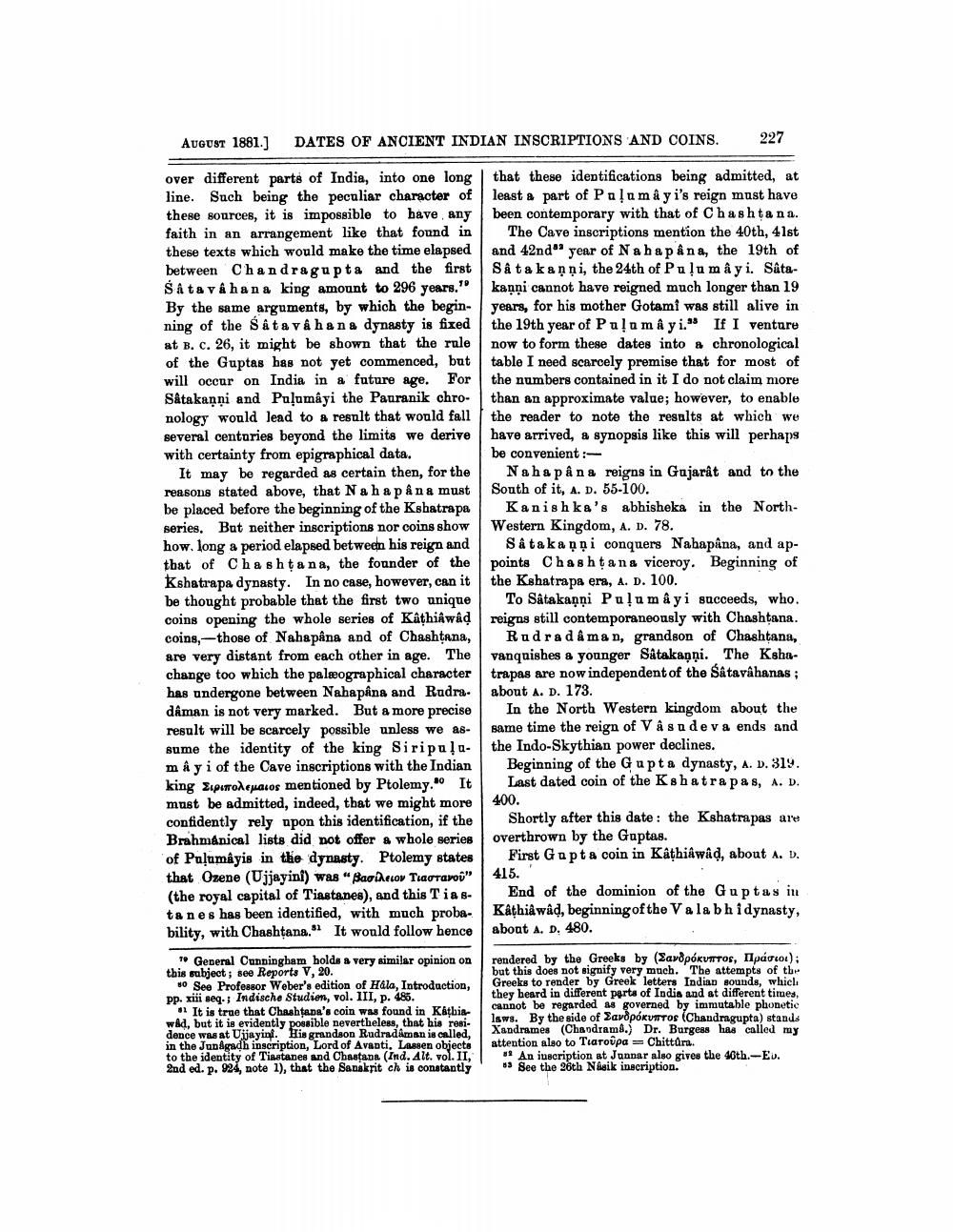________________
AUGUST 1881.] DATES OF ANCIENT INDIAN INSCRIPTIONS AND COINS.
over different parts of India, into one long line. Such being the peculiar character of these sources, it is impossible to have any faith in an arrangement like that found in these texts which would make the time elapsed between Chandragupta and the first Satavahana king amount to 296 years." By the same arguments, by which the beginning of the Satavahana dynasty is fixed at B. c. 26, it might be shown that the rule of the Guptas has not yet commenced, but will occur on India in a future age. For Sâtakanni and Pulumâyi the Pauranik chronology would lead to a result that would fall several centuries beyond the limits we derive with certainty from epigraphical data.
It may be regarded as certain then, for the reasons stated above, that Na ha pâna must be placed before the beginning of the Kshatrapa series. But neither inscriptions nor coins show how long a period elapsed between his reign and that of Chashtana, the founder of the Kshatrapa dynasty. In no case, however, can it be thought probable that the first two unique coins opening the whole series of Kathiawâd coins, those of Nahapâna and of Chashtana, are very distant from each other in age. The change too which the paleographical character has undergone between Nahapâna and Rudra. dâman is not very marked. But a more precise result will be scarcely possible unless we assume the identity of the king Siripuļumây i of the Cave inscriptions with the Indian king Epiroλepatos mentioned by Ptolemy. It must be admitted, indeed, that we might more confidently rely upon this identification, if the Brahmánical lists did not offer a whole series of Pulumâyis in the dynasty. Ptolemy states that Ozene (Ujjayini) was "Barihelor Tiaotaro" (the royal capital of Tiastanes), and this Tia stanes has been identified, with much probability, with Chashtana. It would follow hence
30
General Cunningham holds a very similar opinion on this subject; see Reports V, 20.
80 See Professor Weber's edition of Hala, Introduction, pp. xiii seq.; Indische Studien, vol. III, p. 485.
It is true that Chashtana's coin was found in Kathiawad, but it is evidently possible nevertheless, that his residence was at Ujjayinf. His grandson Rudradaman is called, in the Junagadh inscription, Lord of Avanti, Lassen objects to the identity of Tiastanes and Chastana (Ind. Alt. vol. II, 2nd ed. p. 924, note 1), that the Sanskrit ch is constantly
227
that these identifications being admitted, at least a part of Pulum â y i's reign must have been contemporary with that of Chashtana.
The Cave inscriptions mention the 40th, 41st and 42nd year of Na hapana, the 19th of Satakanņi, the 24th of Puļu mâyi. Sâtakanni cannot have reigned much longer than 19 years, for his mother Gotami was still alive in the 19th year of Pula mâyi." If I venture now to form these dates into a chronological table I need scarcely premise that for most of the numbers contained in it I do not claim more than an approximate value; however, to enable the reader to note the results at which we have arrived, a synopsis like this will perhaps be convenient:
Naha pâna reigns in Gujarât and to the South of it, A. D. 55-100.
Kanishka's abhisheka in the NorthWestern Kingdom, A. D. 78.
Sâtakanni conquers Nahapâna, and appoints Chashṭana viceroy. Beginning of the Kshatrapa era, A. D. 100.
To Sâtakanni Puļu mâyi succeeds, who. reigns still contemporaneously with Chashtana.
Rudradaman, grandson of Chashtana, vanquishes a younger Sâtakanņi. The Kshatrapas are now independent of the Sâtavâhanas; about A. D. 173.
In the North Western kingdom about the same time the reign of V â su deva ends and the Indo-Skythian power declines.
Beginning of the Gupta dynasty, A. D. 319. Last dated coin of the Kshatra pas, A. D. 400.
Shortly after this date: the Kshatrapas are overthrown by the Guptas.
First Gupta coin in Kathiawâd, about A. D.
415.
End of the dominion of the Guptas in Kathiawâd, beginning of the Vala bhi dynasty, about A. D. 480.
rendered by the Greeks by (Σανδρόκυπτος, Πράσιοι);
but this does not signify very much. The attempts of the Greeks to render by Greek letters Indian sounds, which they heard in different parts of India and at different times, cannot be regarded as governed by immutable phonetic laws. By the side of EavopóκUTтos (Chandragupta) stands Xandrames (Chandrama.) Dr. Burgess has called my attention also to Tiaroupa Chittura.
An inscription at Junnar also gives the 46th.-ED. 83 See the 26th Nasik inscription.




